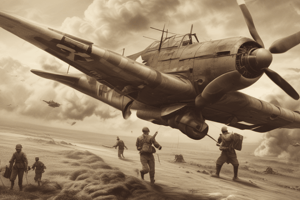Podcast
Questions and Answers
¿Cuál fue el objetivo principal de la ideología Nazi en Alemania?
¿Cuál fue el objetivo principal de la ideología Nazi en Alemania?
- Establecer la supremacía del Imperio Japonés
- Crear una Esfera de Co-Prosperidad en Asia
- Establecer la supremacía de la raza aria y crear un Tercer Reich (correct)
- Crear un nuevo Imperio Romano
¿Qué estrategia militar utilizó Alemania durante la Segunda Guerra Mundial?
¿Qué estrategia militar utilizó Alemania durante la Segunda Guerra Mundial?
- Guerra relámpago (correct)
- Guerra de posiciones
- Guerra de atrición
- Guerra de desgaste
¿Qué país firmó un pacto de defensa mutua con Alemania e Italia en 1940?
¿Qué país firmó un pacto de defensa mutua con Alemania e Italia en 1940?
- Japón (correct)
- Alemania
- Italia
- Polonia
¿Cuál fue el objetivo principal de la estrategia de 'island hopping' utilizada por los Aliados?
¿Cuál fue el objetivo principal de la estrategia de 'island hopping' utilizada por los Aliados?
¿Qué fue una debilidad clave de la alianza del Eje?
¿Qué fue una debilidad clave de la alianza del Eje?
Flashcards are hidden until you start studying
Study Notes
Axis Powers
- The Axis Powers were a group of nations that fought against the Allied Powers during World War II.
- The main Axis Powers were:
- Germany, led by Adolf Hitler and the Nazi Party
- Italy, led by Benito Mussolini and the Fascist Party
- Japan, led by Hideki Tojo and the Imperial Japanese Army
Germany
- Nazi Ideology: Believed in the superiority of the "Aryan" race and sought to create a "Third Reich" (Third Empire)
- Aggressive Expansion: Invaded and annexed several countries, including Austria, Czechoslovakia, and Poland
- Military Strategy: Emphasized blitzkrieg (lightning war) tactics, which involved rapid advances and surprise attacks
Italy
- Fascist Ideology: Believed in the superiority of the Italian nation and sought to create a new Roman Empire
- Military Involvement: Fought in North Africa, the Balkans, and Italy, but suffered significant defeats
- Weaknesses: Italian military was poorly equipped and led, and the country suffered from economic and political instability
Japan
- Imperial Ideology: Believed in the superiority of the Japanese Empire and sought to create a "Greater East Asia Co-Prosperity Sphere"
- Military Strategy: Emphasized surprise attacks, such as the attack on Pearl Harbor, and sought to secure resources and territory in Asia
- Island Hopping: The Allies used a strategy of "island hopping" to bypass heavily fortified Japanese islands and focus on strategic targets
Axis Alliance
- Tripartite Pact: Germany, Italy, and Japan signed a mutual defense agreement in 1940, forming the Axis Alliance
- Cooperation: The Axis Powers cooperated on military strategy, intelligence, and resource sharing, but also had significant disagreements and rivalries
- Weaknesses: The Axis Alliance was weakened by the lack of a unified command structure and the conflicting interests of its member states
Poderes del Eje
- Los Poderes del Eje fueron un grupo de naciones que lucharon contra los Poderes Aliados durante la Segunda Guerra Mundial.
Alemania
- Ideología Nazi: Creía en la superioridad de la "raza aria" y buscó crear un "Tercer Reich" (Tercer Imperio).
- Expansión Agresiva: Invadió y anexionó varios países, incluyendo Austria, Checoslovaquia y Polonia.
- Estrategia Militar: Enfatizó la táctica de blitzkrieg (guerra relámpago), que implicaba rápidos avances y ataques sorpresivos.
Italia
- Ideología Fascista: Creía en la superioridad de la nación italiana y buscó crear un nuevo Imperio Romano.
- Participación Militar: Luchó en África del Norte, los Balcanes y Italia, pero sufrió importantes derrotas.
- Debilidades: El ejército italiano estaba mal equipado y liderado, y el país sufría de inestabilidad económica y política.
Japón
- Ideología Imperial: Creía en la superioridad del Imperio Japonés y buscó crear una "Esfera de Coprosperidad del Gran Este Asiático".
- Estrategia Militar: Enfatizó los ataques sorpresivos, como el ataque a Pearl Harbor, y buscó asegurar recursos y territorio en Asia.
- Saltos de Isla: Los Aliados utilizaron una estrategia de "saltos de isla" para saltar sobre las islas japonesas fuertemente fortificadas y enfocarse en objetivos estratégicos.
Alianza del Eje
- Pacto Tripartito: Alemania, Italia y Japón firmaron un acuerdo de defensa mutua en 1940, formando la Alianza del Eje.
- Cooperación: Los Poderes del Eje cooperaron en estrategia militar, inteligencia y compartir recursos, pero también tuvieron importantes desacuerdos y rivalidades.
- Debilidades: La Alianza del Eje estaba debilitada por la falta de una estructura de mando unificada y los intereses confictivos de sus estados miembros.
Studying That Suits You
Use AI to generate personalized quizzes and flashcards to suit your learning preferences.




